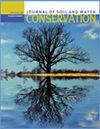Scaling up agricultural conservation: Predictors of cover crop use across time and space in the US upper Midwest
IF 2.6
4区 农林科学
Q2 ECOLOGY
引用次数: 0
Abstract
Scaling up cover crop use will increase crop diversity on agricultural lands and help achieve sustainable production and environmental wellbeing. To increase the total acreage planted to cover crops, more farmers need to use cover crops on a larger proportion of their farms (extent) and for a longer time (longevity), suggesting the importance of spatial and temporal scales of adoption. The adoption literature lacks attention to the spatial and temporal precision of practice measures and misses opportunities to identify consistent or diverse mechanisms for scaling up conservation practices. To fill this gap, we used data from 1,724 corn (Zea mays L.) and soybean (Glycine max [L.] Merr.) farms in Illinois, Indiana, Michigan, and Ohio to study three measures of cover crop usage: the use of cover crops in a single year on a specific field, the percentage of acres planted to cover crops on a farm in a single-year, and years of cover crop use. Our models included key biophysical, operational, policy, social, and psychological factors. We hypothesize that predictors of cover crop adoption and intensity and longevity of use differ. Our results revealed five factors that performed consistently across measures (perceived benefits of cover crops, knowledge, profitability goals, no-till, and rotational diversity), while the effects of the other seven factors varied, including sustainability goals that were only associated with the longevity of use. Policy programs that aim at increasing cover crop use should consider which aspect of scaling-up is being targeted, then focus on corresponding factors that can better tailor policy and education programs to farmer motivations and decision-making contexts.扩大农业保护:美国中西部上部覆盖作物利用的时空预测因子
扩大覆盖作物的利用将增加农业用地上的作物多样性,并有助于实现可持续生产和环境福祉。为了增加覆盖作物的种植面积,更多的农民需要在更大比例的农场(范围)和更长的时间(寿命)上使用覆盖作物,这表明了采用空间和时间尺度的重要性。采用文献缺乏对实践措施的空间和时间精度的关注,并且错过了确定扩大保护实践的一致或多样化机制的机会。为了填补这一空白,我们使用了1,724种玉米(Zea mays L.)和大豆(Glycine max [L.])的数据。在伊利诺斯州、印第安纳州、密歇根州和俄亥俄州的Merr.)农场研究覆盖作物使用的三种方法:一年中特定田地覆盖作物的使用,一年中农场种植覆盖作物的面积百分比,以及覆盖作物使用的年份。我们的模型包括关键的生物物理、操作、政策、社会和心理因素。我们假设覆盖作物采用率、使用强度和使用寿命的预测因子不同。我们的研究结果揭示了五个因素在测量中表现一致(覆盖作物的感知效益、知识、盈利目标、免耕和轮作多样性),而其他七个因素的影响各不相同,包括仅与使用寿命相关的可持续性目标。旨在增加覆盖作物利用的政策计划应考虑扩大规模的哪个方面是目标,然后将重点放在能够更好地根据农民动机和决策环境定制政策和教育计划的相应因素上。
本文章由计算机程序翻译,如有差异,请以英文原文为准。
求助全文
约1分钟内获得全文
求助全文
来源期刊
CiteScore
4.10
自引率
2.60%
发文量
0
审稿时长
3.3 months
期刊介绍:
The Journal of Soil and Water Conservation (JSWC) is a multidisciplinary journal of natural resource conservation research, practice, policy, and perspectives. The journal has two sections: the A Section containing various departments and features, and the Research Section containing peer-reviewed research papers.

 求助内容:
求助内容: 应助结果提醒方式:
应助结果提醒方式:


